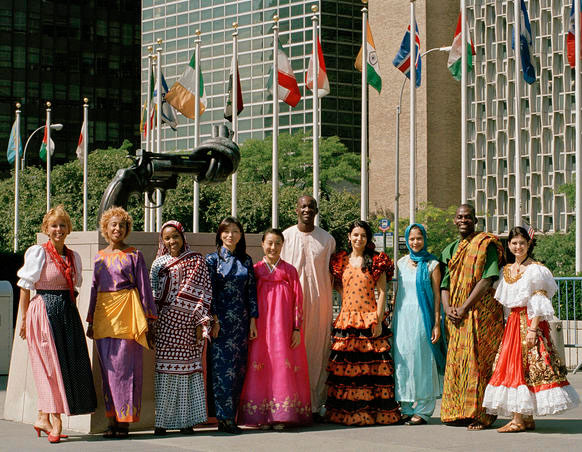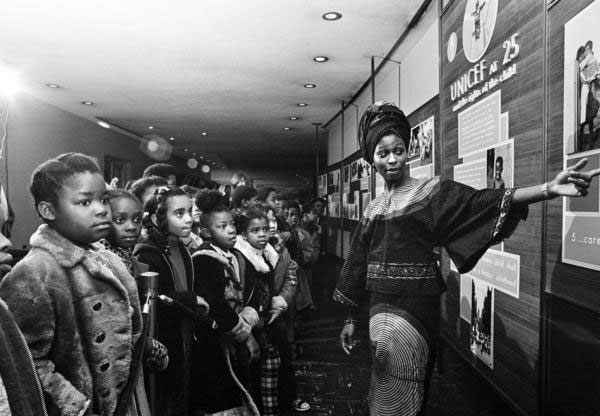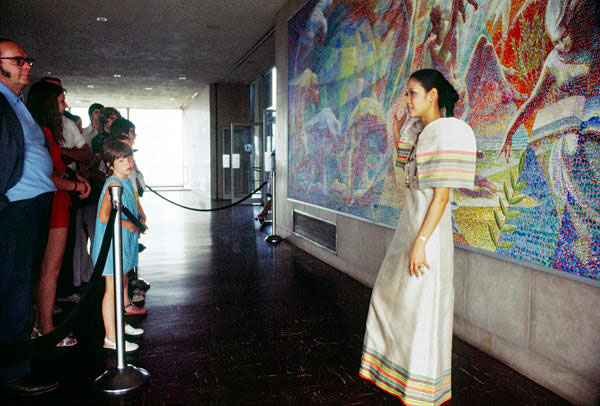FEATURE: Sixty Years of UN Guided Tours
To celebrate the 60th anniversary of the UN Guided Tours, we take a closer look at the work of those at the heart of presenting the UN to the public, the UN tour guides.
Has the Security Council adopted a new resolution to deal with the crisis in Mali?
How much have food prices increased in the past month and how is that affecting the world’s poor?
A tour guide at United Nations Headquarters in New York must know the answers to all these questions for they can all potentially be asked by visitors in the next few hours.

A group of tour guides in their national dress in front of the sculpture entitled 'Non-Violence' at UN Headquarters in New York. UN Photo/Andrea Brizzi
So, with this in mind, every day, at 9:15 a.m. and 10:00 a.m., UN tour guides attend a briefing where they get up to speed on the latest developments on international affairs – in particular, on what the world body is doing in relation to them.
On average, a tour guide will give four hourly tours on a daily basis, each one potentially in a different language. In just 60 minutes, visitors will not only see the rooms where key bodies such as the Security Council and the General Assembly hold session, they will also receive a detailed but boiled-down version of how the biggest international organization in the world functions, a snapshot of some of the issues and crises currently on its agenda, and, hopefully, get a sense of what it is like to work at the world body.
Since they first began in November 1952, some 40 million people from all over the world have taken part in the guided tours of UN Headquarters, and for many of those millions, their encounter with UN tour guides will have been their first – and for some, their only – direct contact with a staff member from the world body.
“Once, I made the calculation with some colleagues that, on average, every year each tour guide speaks with 15,000 people for one hour only about the subject of the United Nations,” said Carmel Irandoust, a former tour guide from France who is now working at the UN’s Protocol and Liaison Service. “In my time as a tour guide, I learned that you really are the voice and the face of the United Nations to the world.”
The tours take visitors through some of international relations’ more historic venues – such as the General Assembly and Security Council chambers – but include much more, such as inspecting donated works of art from all over the world; viewing an exhibition on disarmament, where visitors can see landmines of various shapes and sizes as well as melted-down remnants from the nuclear explosions in Nagasaki and Hiroshima at the end of the World War II.
UN tour guides hold a regular morning briefing.
Visitors also learn about peacekeeping and the work that the UN system is doing to achieve the anti-poverty targets known as the Millennium Development Goals (MDGs), in addition to receiving a potted history of the UN Headquarters complex itself.
However, to show people in just one hour what the UN actually is as opposed to what it is perceived to be can be tough, which is why tour guides have to be creative in explaining what the UN stands for and how it works, all while being aware of the political sensitivities of different issues.
“I always tried to be as objective as possible,” Ms. Irandoust said. “One example that always came to my mind during the tours, and that I love to share, is to compare the world as one human body. If you have one part that is hurting, it is difficult to get rid of it or cut it. The work of the United Nations is to unite and try to heal this part that is hurting. It would be difficult to have the brain or the heart refuse to help a leg that is hurting or a hand, that really wouldn’t make sense.”
Every guide has a different style and the consensus among them is that no two tours are alike, and that the same information may elicit different reactions depending on the audience, meaning that guides must be ready to address difficult questions and critical opinions regarding the work of the UN.
Jacky Tong, a current tour guide from Malaysia who gives tours in English and Mandarin, has developed a role-playing game to explain to visitors how peacekeeping works.

A group of school children listen their UN tour guide, Afua Lokko of Ghana, as she talks about a UNICEF exhibit on the 'Rights of the Child'. UN Photo/Yutaka Nagata
“The point of the role play is to get people to understand the complexity of peacekeeping in just a few minutes and to take them from one dimensional to multidimensional peacekeeping,” he said.
“The toughest questions are about the Security Council,” said Maty Fall from Senegal, who gives the tour in English and French. “People can be critical about the five permanent members and their veto power so the most difficult questions will usually happen when we visit the Council.”
Madoka Koide, a former tour guide who now works in the Office of the Spokesperson for the Secretary-General, recalled that the trickiest questions were those of a very broad scope being asked at the end of the tour.
“Somebody would ask something along the lines of ‘If there is the UN, why are there still wars in the world?’ and then you feel like: ‘do I have to answer that in 30 seconds before my next tour?’”
While these situations may seem intimidating, many tour guides view them as one of the most exciting parts of the job, relishing the chance to try to inform someone on the role the UN plays in the world, or making a lasting impact that will prompt them to learn more – or even join the UN in the future.
“Throughout my years as a tour guide I made people laugh as well as cry,” says Heidy Maltinez, who now works at the UN Children’s Fund (UNICEF). “It is a great feeling to know that after the tour many visitors changed their opinions about the work of the Organization and that even if they forget the details of the tour, they always kept the message.”
A UN tour guide, Kateryna Bieliaieva, walks a group of visitors through an exhibition on disarmament.
Tour guides may go on to occupy various positions within the UN, and many agree that their experiences as guides have helped them in their current jobs. Most of them also develop tight-knit friendships, as they work in a particularly close environment.
“It is a poorly-kept secret that we have a lot of fun,” said the tour guide’s supervisor, Elisabeth Waechter, the chief of the UN Department of Public Information’s Visitors Services. “I feel very blessed to be able to work with a team of such young, energetic, multi-cultural, multi-lingual and enthusiastic people. For many guides, this is their ‘home from home’ where lifelong friendships are forged.”
She added, “Guided Tours have been a firm feature of the United Nations in New York ever since the buildings opened in 1952. The guides play a pivotal role in shaping the general public's understanding of the work of the United Nations and all of us take this responsibility as ‘Ambassadors to the Public’ very seriously.”
During their lunch break, some guides can be seen sharing food at a round-table in the guides’ lounge. Others will be sitting on couches talking, or browsing the web on the computers in the room. Some will be wearing their traditional country dress, while others will wear the official suit that has evolved through the years, and has been designed by renowned fashion houses, including Christian Dior and Benetton.
“We used to share everything, computers, food on the international table, even the blankets during break time,” according to Ms. Maltinez. “Every time a guide came back from tour it was a tradition to share with the others any anecdote, tricky question or interesting information received on tour.”
Abbie Krasne, who was a tour guide in 1954, recently visited the current guides to share with them a few of her experiences as one of the first people to hold this position. As she walked into the room, tour guides surrounded her, curious and a little in awe of a woman, who at 80 years of age, seems ready to take on the world.
Has much changed since her days as a tour guide? Tour guides want to know.
“Much has changed and nothing has changed,” she said, highlighting one of the biggest changes since she served as a guide: previously, the positions were reserved exclusively for women, with men unable to be UN tour guides until 1977.
“This was considered a glamour job,” Ms. Krasne said. “But in many ways it felt like we were getting a post-graduate education in international affairs. At the same time, the atmosphere was always very friendly.”
Ms. Krasne, who still remembers meeting Eleanor Roosevelt – a noted campaigner for civil and human rights in her own right, in addition being the of US President Franklin Delano Roosevelt – before giving a tour to her son, says there was a crisp feeling of being part of a new organization that “had been tasked with huge responsibilities.”
Comparing the challenges and issues before the world body now and then, Ms. Krasne said they appear to be more complex today. “But I still believe it is extremely important, as it is still the only place where countries can come together to talk about issues,” she added.
While some things have remained the same, tour guides now interact with visitors not just through the actual tours they conduct, but also through various social media platforms, regularly answering questions on Facebook and Twitter to keep the conversation with the visitors going well after visitors have left the UN Headquarters complex, as well as provide an opportunity for them to ask lingering or later questions.
“We want to convey to visitors that we are open, we are here and we are social,” said Kateryna Bieliaieva, one of the tour guides who is active on Twitter. “The UN is big and may seem unapproachable for them, but the moment you mention the Twitter account, they get engaged and involved.”
The guided tour has also evolved over time to cater for different audiences. For example, tours for disabled people have been devised, and there have been specific tours which focus more on the art and architecture of UN Headquarters – the complex boasts a range of artefacts and treasures from around the world, so much so that it has been described as a living museum by some.
In addition, the growing number of children being brought to the tours has led to the development of a tour designed especially for children, who are one of the most enthusiastic audiences, according to the guides.
“Kids would be in awe, when told that FAO’s [Food and Agriculture Organization] Codex Standard dealt with frozen french fries and various kinds of chocolates, that English is the common language of aviators because of International Civil Aviation Organization (ICAO), and that the work of the International Postal Union (IPU) involves letters sent to Santa Claus,” said Suhail Khan, a former guide from India who is now working at the Office of the Special Representative for the Secretary-General on Sexual Violence in Conflict.
On 15 November, past and current tour guides will have a reunion at UN Headquarters to mark the 60th anniversary of the world body’s guided tours, providing an opportunity to reconnect with former colleagues, reminisce about their time as the UN’s face to the public, and hear first-hand how things have changed – or not.
“The one thing that will never change about guided tours at the United Nations,” said Ms. Waechter, “is the dedication to provide up-to-date pertinent information about the work of the Organization to a wide range of audiences and I am excited to see how many different ways we can find in the future to live up to that mandate.”



